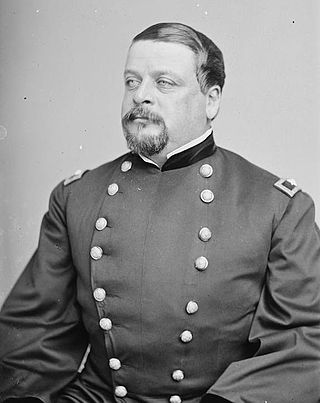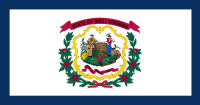The Army of the Shenandoah was a field army of the Union Army active during the American Civil War. First organized as the Department of the Shenandoah in 1861 and then disbanded in early 1862, the army became most effective after its recreation on August 1, 1864 under the command of Philip Sheridan. The army's actions during the Valley campaigns of 1864 rendered the Shenandoah Valley of Virginia unable to produce foodstuffs for the Confederate States Army, a condition which would hasten the conclusion of the American Civil War.

The American Civil War saw extensive use of horse-mounted soldiers on both sides of the conflict. They were vital to both the Union Army and Confederate Army for conducting reconnaissance missions to locate the enemy and determine their strength and movement, and for screening friendly units from being discovered by the enemy's reconnaissance efforts. Other missions carried out by cavalry included raiding behind enemy lines, escorting senior officers, and carrying messages.
The town of Romney, Virginia, traded hands between the Union Army and Confederate States Army no fewer than 10 times during the American Civil War, assuming the occupying force spent at least one night in the town. The story of the small town is emblematic of the many military campaigns that swept through western Virginia and, later, the new state of West Virginia.
The 8th Ohio Cavalry Regiment was a regiment of Union cavalry raised by the state of Ohio for service during the American Civil War. It served in the Eastern Theater, primarily in West Virginia and then in the Shenandoah Valley region of Virginia.
Loudoun County, Virginia, was destined to be an area of significant military activity during the American Civil War. Located on Virginia's northern frontier, the Potomac River, Loudoun County became a borderland after Virginia's secession from the Union in early 1861. Loudoun County's numerous Potomac bridges, ferries and fords made it an ideal location for the Union and Confederate armies to cross into and out of Virginia. Likewise, the county's several gaps in the Blue Ridge Mountains that connected the Piedmont to the Shenandoah Valley and Winchester were of considerable strategic importance. The opposing armies would traverse the county several times throughout the war leading to several small battles, most notably the Battle of Ball's Bluff.

The Loudoun Rangers, also known as Mean's Rangers for their commander, Samuel C. Means, was a partisan cavalry unit raised in Loudoun County, Virginia, that fought for the Union during the American Civil War. The Rangers have the distinction of being the only unit raised in present-day Virginia to serve in the Union Army.
The 9th West Virginia Infantry Regiment was an infantry regiment that served in the Union Army during the American Civil War.
The 91st Ohio Infantry Regiment, sometimes 91st Ohio Volunteer Infantry Regiment was an infantry regiment that served in the Union Army during the American Civil War. It primarily served in what became West Virginia and in the Shenandoah Valley of Virginia.

McNeill's Rangers was an independent Confederate military force commissioned under the Partisan Ranger Act (1862) by the Confederate Congress during the American Civil War. The 210 man unit was formed from Company E of the 18th Virginia Cavalry and the First Virginia Partisan Rangers. After the repeal of the Act on February 17, 1864, McNeill's Rangers was one of two partisan forces allowed to continue operation, the other being 43rd Battalion Virginia Cavalry. Both of these guerrilla forces operated in the western counties of Virginia and West Virginia. The Rangers were known to exercise military discipline when conducting raids. However, many Union generals considered Captain John Hanson McNeill (1815–1864) and his men to be "bushwhackers," not entitled to protection when captured, as was the case with other prisoners of war.

Alfred Gibbs was a career officer in the United States Army who served as an officer during the Mexican-American War and Apache Wars. He served as a brigadier general in the Union Army during the American Civil War.

The 43rd Virginia Cavalry Battalion, also known as 43rd Virginia Rangers, Mosby's Rangers, Mosby's Raiders, or Mosby's Men, was a battalion of partisan cavalry in the Confederate Army during the American Civil War. Noted for their lightning strike raids on Union targets and their ability to consistently elude pursuit, the Rangers disrupted Union communications and supply lines.

The 35th Virginia Cavalry Battalion, also known as White's Battalion, White's Rebels and the Comanches, was a Confederate cavalry unit during the American Civil War raised by Elijah V. White in Loudoun County, Virginia in the winter of 1861-62. The battalion was initially raised as border guards along the Potomac River below Harpers Ferry but were ultimately mustered into regular service as part of the Laurel Brigade. Despite this, they continued to play a conspicuous role in the ongoing partisan warfare in Loudoun throughout the war. The battalion was particularly notable during the 1863 Gettysburg Campaign, when it played a prominent role in the Battle of Brandy Station and subsequently conducted a series of raids on Union-held railroads and defensive positions in Maryland and Pennsylvania. The 35th was the first Confederate unit to enter Gettysburg, Pennsylvania.

Guerrilla warfare was waged during the American Civil War (1861–1865) by both sides of the conflict, but most notoriously by the Confederacy. It gathered in intensity as the war dragged.
The George's Schoolhouse Raid was a Confederate partisan raid led by local guerrilla John Mobberly on the Union garrison at Lovettsville in Loudoun County, Virginia on January 17, 1865, during the American Civil War. The raid was tactically inconclusive. After surprising the sleeping garrison, the Confederates were driven away by superior force, taking with them only a few horses and prisoners. The raid is notable for being the last partisan action in Loudoun County involving Elijah V. White's 35th Battalion of Virginia Cavalry.
Carr Baily White (1823–1871) was a physician, an officer during the Mexican War and a general during the American Civil War. His Civil War service was entirely in western Virginia and Maryland.
The Kanawha Division was a Union Army division which could trace its origins back to a brigade originally commanded by Jacob D. Cox. This division served in western Virginia and Maryland and was at times led by such famous personalities as George Crook and Rutherford B. Hayes.

The 62nd Virginia Mounted Infantry Regiment, raised in Virginia for service in the Confederate States Army during the American Civil War, served in many capacities including the war, including as an infantry regiment, a cavalry regiment, a mounted infantry (dragoon) unit, a partisan unit of rangers, and even as a combined arms unit. It fought mostly with the Army of Northern Virginia and in western Virginia. The men were recruited primarily in the counties of Hardy, Hampshire, Barbour, Pendleton and Pocahontas in West Virginia and Augusta and Highland in Virginia .

The 18th Virginia Cavalry Regiment was a cavalry regiment raised in Virginia for service in the Confederate States Army during the American Civil War. It fought with the Army of Northern Virginia, in southwest Virginia, and in the Shenandoah Valley.

The Warrenton Junction Raid was a surprise attack by Confederate guerrilla warriors on a Union cavalry detachment during the American Civil War. The raid took place near a railroad junction in Virginia's Fauquier County, less than 10 miles (16 km) from the town of Warrenton. Confederate Major John S. Mosby led the attack against about 100 men from the Union's 1st (West) Virginia Cavalry. At first, the raid was very successful, as many of the Union soldiers surrendered to the rebels. The remaining portion of the surprised force was surrounded in a house, and two of their leaders were wounded. The house was set on fire, and the Union soldiers surrendered. As Mosby's men rounded up prisoners and horses, a detachment of the 5th New York Cavalry surprised the rebels and rescued most of the captured Union soldiers. After a short fight, more men from the 5th New York, and the 1st Vermont Cavalry, joined in the pursuit of Mosby's fleeing rebels.

The 14th Pennsylvania Cavalry Regiment was a cavalry regiment of the Union Army during the American Civil War. Most of its fighting happened in the last half of 1863 and full year 1864. The regiment fought mainly in West Virginia and Virginia, often as part of a brigade or division commanded by Brigadier General William W. Averell and later Brigadier General William Powell.









